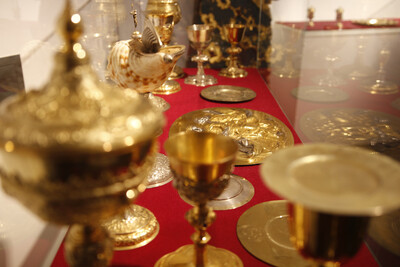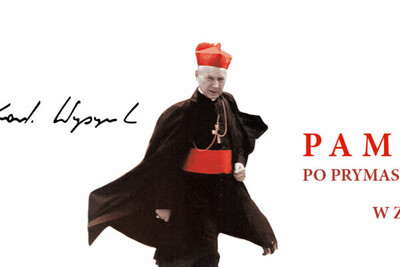On the 3rd floor, with a total space of 1200 m2, the museum exhibits religious and secular works of art. The almost 20,000 piece collection consists of: paintings, drawings, graphic works, gold objects and sculptures, old elements of church decor, liturgical vestments and vessels, medals, gorgets, furniture, clocks, etc. The exhibits come from donations from parishes, congregations, priests and laypeople. Most of the works are items acquired after World War II. Some items from the museum’s prewar collection have also been recovered.
On permanent display are works by Polish and foreign artists, including: Malczewski, Hofman, Czechowicz, Smuglewicz, Lebenstein, Kuna, Karny, Czapski, Beksiński, and Bassano, and mementos connected with outstanding Poles, such as Pope John Paul II, the Blessed Jerzy Popiełuszko and Cardinal Stefan Wyszyński.
History
The Museum of the Archdiocese of Warsaw was opened in September 1938, one year before the outbreak of World War II. At first, it was located in a tenement building on Kanonia Street behind the Warsaw Cathedral.
At that time, the museum housed a gallery of Gothic sculpture, a gallery of old sacred fabrics and some gold objects.
The museum building and the collections were destroyed in World War II (1939 – 1945), especially after the Warsaw Uprising in 1944 when on Hitler’s order the entire Old Town was completely demolished and the most valuable objects were carried off by the Germans.
After World War II, many of the stolen works were recovered; however, they were incorporated into the collections of the national museums. For many years during the Polish People’s Republic, when the communist government was dedicated to fighting the Church and secularizing Poland, the state authorities did not agree to the reopening of the Diocese Museum in Warsaw.
Regardless of the difficult circumstances, in the 1970s, on the initiative of the Polish Primate, Cardinal Stefan Wyszyński, ancient works of art, mainly liturgical vestments, were gradually accumulated in the Cathedral Archives. Thanks to the Primate’s determination, the state authorities finally agreed to the reopening of the Diocese Museum. The former monastery of the Trinitarian fathers at the Holy Trinity Church in the Solec neighborhood of Warsaw became the new seat of the Museum of the Archdiocese of Warsaw, which reopened in April 1980.
The museum’s collection covers drawings, coins, paintings, sculptures, cloths, medals, and gold objects, and includes almost 20,000 items.
When martial law was imposed in Poland in December 1981, the museum was one of the places that supported the opposition’s activity against the communist system. A group of artists, actors and musicians was active at the museum at that time. There were patriotic and religious exhibitions, concerts, readings and theater evenings. Eminent actors and artists were connected with the museum. The elite of the theater world and other fields of art gathered at the museum. Varsovians still have vivid memories of that period of the museum’s activity.
The next important event in the museum’s history was its transfer to a new location in the Old Town. After renovation and adaptation works (2011 – 2015) of the building next to St. John the Baptist Cathedral called the Deacon’s Palace, the museum was ceremoniously consecrated and opened in November 2015. Thus, history came full circle because the museum’s current location on Dziekania Street is only about 300 m. from its first location on Kanonia Street.
| Day of the week | Opening hours | ||
|---|---|---|---|
| Tuesday | 12:00 - 18:00 | ||
| Wednesday | 12:00 - 18:00 | ||
| Thursday | 12:00 - 18:00 | ||
| Friday | 12:00 - 18:00 | ||
| Saturday | 12:00 - 16:00 | ||
| Sunday | 12:00 - 16:00 | ||
| Holidays | Opening hours |
|---|---|
| 2025.08.15 (Friday) | x |
| 2025.11.01 (Saturday) | x |
| 2025.11.11 (Tuesday) | x |
| 2025.12.25 (Thursday) | x |
| 2025.12.26 (Friday) | x |
| Tickets | ||
|---|---|---|
| normal | 20.00 PLN | |
| reduced | 14.00 PLN | |
| family | 45.00 PLN | max. 2 osoby dorosłe i 3 dzieci do 18. roku życia |
| children free of charge up to the age of 7 |
| Guide | |
|---|---|
| in Polish for a fee | 180.00 PLN |
| in English for a fee | 250.00 PLN |
| in French for a fee | 250.00 PLN |
| in Ukrainian for a fee | 250.00 PLN |
| Additional information | |
|---|---|
TEMPORARY EXHIBITION |
| when? | name | where? | about what? | for free | for children | |
|---|---|---|---|---|---|---|
 | Sacrum i profanum Permanent exhibition | The Museum of the Archdiocese of Warsaw ul. Dziekania 1 00-279 Warszawa Masovian | art crafts, devotional articles, graphics and drawing, painting, sculpture | |||
 | Błogosławiony Stefan Wyszyński - Prymas Tysiąclecia Permanent exhibition | The Museum of the Archdiocese of Warsaw ul. Dziekania 1 00-279 Warszawa Masovian | characters, devotional articles, documents, medals and badges |